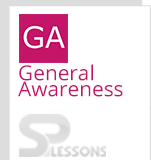 Introduction
Introduction
General Awareness is an important component of most of the competitive exams for employment in the government sector in India. The article UPSC NDA and NA Mains General Awareness Quiz 2 presents questions related to IBPS PO, SSC CGL, SSC MTS, SSC CHSL, SEBI Grade A, Indian Bank PGDBF PO, LIC HFL, NIACL Assistant, RRB Assistant, RRB PO, SBI Clerk, SBI PO, RBI Grade B and BOB PGDBF PO. The article UPSC NDA and NA Mains General Awareness Quiz 2 have been designed keeping in view the significant role of General Awareness sections in the scoring of competitive exams. UPSC NDA and NA Mains General Awareness Quiz 2 is very useful to crack the General Awareness sections of several competitive exams.
 Quiz
Quiz
1. Which of the following statements are true about Jehangir?
I. His reign saw the beginning of a new intercourse between Europe and India
II. He attempted to prohibit traffic in eunuchs
III. He started practices of inter-caste marriages between the families of government officers
IV. He ordered the abolition of inhuman corporal punishments
- A. I, II, and III
B. I, II, and IV
C. II, III, and IV
D. All the above
- A. Both I and II are correct
B. Both I and II are incorrect
C. Only I is correct
D. Only II is correct
- A. Shah Jahan & Aurangzeb
B. Shah Jahan & Aurangzeb
C. Akbar Jahan & Jahangir
D. Shah Jahan & Jahangir
E. Jahangir & Humayun
- A. Jahangir
B. Shah Jahan
C. Akbar
D. Aurangzeb
- A. Aurangzeb
B. Akbar
C. Shah Jahan
D. Jahangir
1. At which one of the following places, India’s first atomic power station started?
- A. Kalpakkam
B. Rana Pratap Sagar
C. Narora
D. Tarapur
- A. Tamil Nadu
B. Telangana
C. Jharkhand
D. Madhya Pradesh
- A. 1st
B. 2nd
C. 3rd
D. 4th
- A. Market
B. Population Density
C. Capital
D. Power
- A. IISCO
B. TISCO
C. Visvesvaraiya Iron and Steel Works
D. Mysore Iron and Steel Works.
1. Which of the following is not true regarding the Office of the Chief Election Commissioner of India?
- A. President appoints the Chief Election Commissioner of India
B. Chief Election Commissioner is nowhere mentioned in the Constitution of India
C. Chief Election Commissioner’s salary is equal to a judge of the Supreme Court
D. T Swaminathan was the first Chief Election Commissioner of India.
- A. To safeguard public property
B. To protect and improve the natural environment
C. Respecting women
D. To develop the scientific temper and spirit of inquiry
- A. Rajya Sabha
B. President
C. Lok Sabha
D. Prime Minister
- A. Government of India Act, 1919
B. Government of India Act, 1935
C. Government of India Act, 1919
D. Government of India Act, 1909
- A. Indian Councils Act, 1909
B. Government of India Act, 1919
C. Government of India Act, 1935
D. None of the Above



